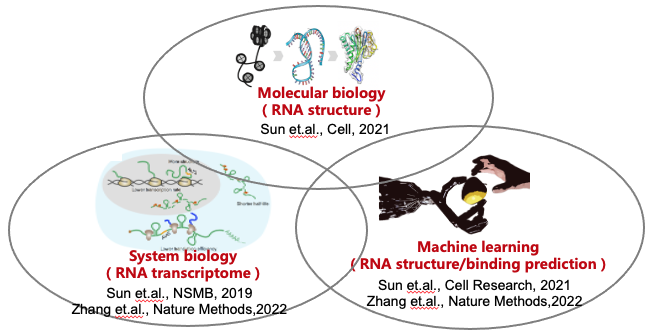
Lei Sun (孙磊),PI
I started RNA strcuturome lab at Shandong University (Qingdao) in December of 2022. Our lab broadly interested in RNA biology, especially RNA structure biology, RNA vaccine and adaptor design, and anti-RNA virus drug development (such as SARS-CoV-2). Our lab will develop and use a combination of computational and experimental methods to interpret the structural and functional relationships of biological macromolecules, build the interaction network, uncover the regulation mechanism and find the potential therapy for diseases based on high-throughput sequencing, bioinformatics analysis, artificial intelligence (AI) prediction, and experimental validation.From 2019 to 2022, I was a Postdoc researcher at Tsinghua University, cooperating with Prof. Qiangfeng Cliff Zhang. Before my Postdoc period, I received my Ph.D. degree in the School of Life Science, Tsinghua University in 2019. Before I came to Tsinghua University, I received a bachelor's degree in Taishan College, Shandong University in 2014.
Please feel free to directly contact me via e-mail for formal or informal inquiries: sunlei0227 at sdu.edu.cn.

1. Technology development
Our lab is both interested in experimental and computational methods development. We have taken part in
the development of many
technologies including subcellular RNA structure determination (Sun et.al., NSMB, 2019
)and RBP-RNA interaction prediction based
on artificial intelligence (Sun et.al., Cell Research, 2021).
We are also interested in single-cell RNA structure determination, and co-transcriptional transient RNA
structure determination in the future.
2. Biological question
RNA structure and RBP-RNA interactions play key roles in post-transcriptional regulation. The regulatory
network of viruses can be studied from the perspectives
of RNA structure and RNA-protein interaction by icSHAPE, PrismNet, CLIP, and other techniques. Antiviral
drugs can be developed by targeting important structural
elements of viruses or interacting host proteins (Sun et.al., Cell, 2021).
It is important to note that the integration of high-throughput sequencing, deep learning models,
and experimental validation provides a viable idea to systematically study the role of RNA-binding
proteins. For example, how do RBPs regulate gene expression during zebrafish development?
3. Technical applications
Based on previous work, we have identified a large number of conserved RNA structural elements related to
RNA translation, RNA degradation, etc. These RNA structures can be exploited to design
RNA molecules that better help the vaccine and RNA targeting drug development. Moreover, the
understanding of RNA structure and the application of artificial intelligence can help us to design
better
gRNA in the RNA therapy field.